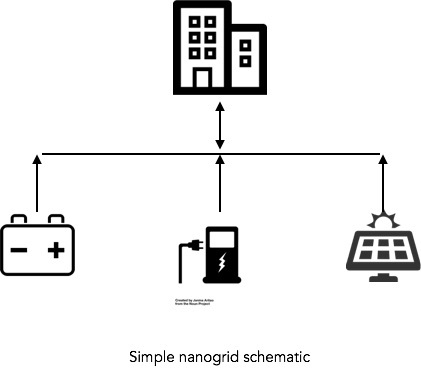One of the ongoing issues with the transition to a new utility paradigm, for both consumers and providers, is the required change from a centralized to a distributed framework. Utilities are worried that consumers will abandon the power coming from a big power station far away in favor of the solar panel on their roofs, the tesla powerwall in their homes and the extra power from their neighbor. At the same time consumers are worried that the new forms of energy will cost them more than they currently pay and not everyone wants to 'pay a premium to promote renewables'. Good news is that there is a transition opportunity that helps achieve the goals and desires of the consumer for safe (read as clean), reliable and stable power. They are called Nanogrids and Minigrids.
Nanogrids: are considered as discrete loads (the power drawn) that sometimes use direct current (DC) to reduce on energy losses that we normally see in long distance energy transmission. Navigant suggests a 5kW capacity for standalone systems and 100kW capacity if the system is tied to the current grid. Sidenote: think of kW as stock (energy in a tank) and kWh as flow (power used by your ac). The off-grid central Texas farm with its solar panels and its diesel generator on the back of the pickup truck is already operating as a nanogrid. Why is it less disruptive to the the utility? Because nanogrids, at current scale, do not take too much off the plate of the utility enabling them make the adjustment in a more transitional way. Why is it good for consumers? The ability to manage your own generation, demand and usage using renewable energy is where we are all going so why not get there earlier than others. The fascinating thing is that in African countries, including the one where I was born, either through lack of infrastructure or depreciated assets this is already the case. I wrote about my fathers generation serving as their own Youtility with each home running a nanogrid unto itself with a generator combined with solar energy for power, a borehole dug in the back of the compound for water and gas tanks swapped out at the gas station for cooking gas. A nanogrid...
MiniGrid: So what do you get when you combine nanogrids? Doesn't take too much of a leap in imagination to see what a minigrid is; in lay terms it is a modular collection of nanogrids. It is often a collection of demand nodes (buildings) all pulling from one or a few distributed energy sources (a solar array and some storage). The difference from the current microgrid or centralized utility structure is in the size. There will be wires required to connect the homes and commercial buildings, which is not the case in a nanogrid, but not at the range that the current grid covers. This structure of grid lends itself to the pay-as-you-go model of electricity usage that is prevalent in the developing countries where this is already in play. This is a model that can be borrowed for low-income areas of most of our fast changing cities, a model that starts to cater to the customization of service that the future utility (customer) will demand.
Nanogrids and minigrids will play a big role in the smart and connected homes we will all live in in the future and consequently the minigrid system will heavily impact the smart city future that is upon us. It is quite ironic that is a grid system that we in the US will be borrowing from developing countries where the lack of infrastructure is forcing the fast adoption of these systems. The utility, in it's current state, will play some role in this future.
What is required is for the utility to take their vast reserves of cash and infrastructure and decide which part of the value chain - infrastructure, technology or people - their strengths lie.
It is a decision that needs to be made soon.



